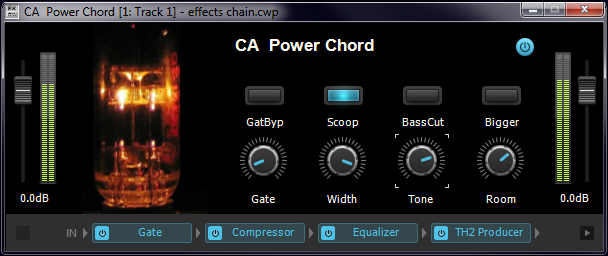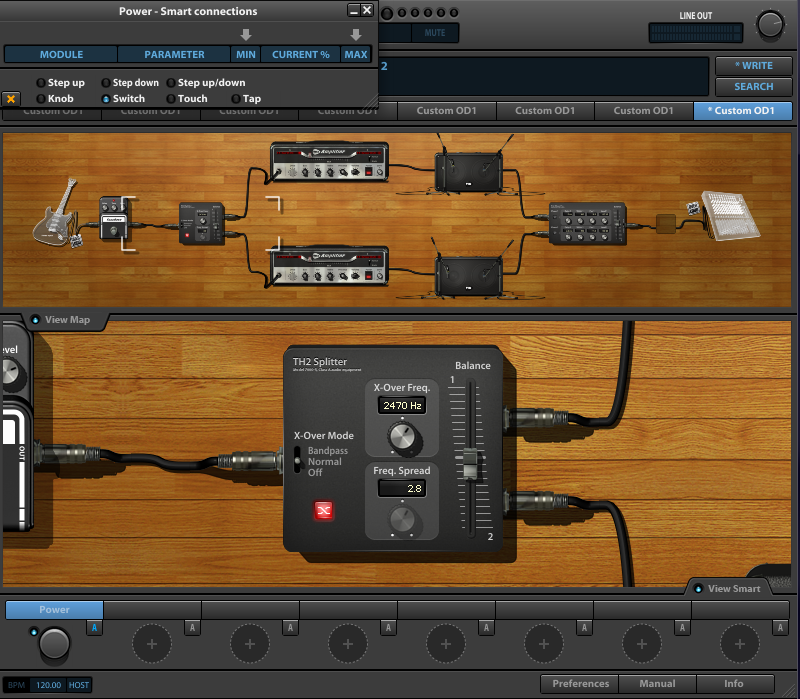Let’s de-construct an FX Chain, and find out how to optimize distortion guitar sounds
by Craig Anderton
I like big, rich, smooth power chords—harshness need not apply. While TH2 Producer’s presets were a point of departure, I wanted to take them further.

So I got to work on an FX Chain, and I’m happy to share it with you. The final FX Chain ended up as Gate > Compressor > Equalizer > TH2 Producer > Equalizer > Delay > Reverb. The following explains why each module was chosen, and how it was tweaked. Note that all the additional effects use the Sonitus processors.
I tested this with the Gibson LPX (which allows all common pickup switching and then some), and it’s optimized for humbuckers. However, parallel humbucker connections sound especially good, and single coil sounds distort well although of course, they don’t sound quite as “thick.”
TH2 Producer. TH2 is one of the rare guitar processors with a crossover, so I started by splitting the guitar signal (which had been distorted by the FussRace) at 2,470Hz, then sending each path into an amp/speaker combination. This produces a more “focused” sound than feeding through a single amp/cab combo, and also allowed for a bass cut (see later)
Here’s a screen shot of the “pre-TH2” effects chain (descriptions follow).
Gate. As this is a high-gain circuit, you don’t want low-level signals coming out of the guitar to be amplified and processed. By placing the gate right after the guitar, the threshold can be low, and the action not to drastic to give a smooth gating effect. However, there’s a Gate knob in the FX Chain that adjusts threshold, and Gate Bypass button. This toggles the Gate output between Audio (the sound processed by the gate) and Sidechain, which in this case is the signal going into the gate.
Compressor. Reducing dynamics somewhat gives a more predictable signal for the distortion, while increasing sustain and also smoothing out the sound a bit. The threshold isn’t excessively low, but the 8:1 ratio applies a significant amount of compression once the signal exceeds the threshold.
Pre-TH2 EQ. Most guitarists are aware that turning down the guitar’s tone control to take out the highs gives a creamier distortion sound, and that’s what this EQ does. It also takes out some of the lows in case there are signals below the guitar’s range
Now here’s a screen shot of the “post-TH2” effects chain (descriptions below).
Post-TH2 EQ. The provides post-distortion tone control. The FX Chain’s Tone knob edits the EQ’s high-frequency shelf (Band 5), while the Scoop button takes out the mids (Band 3). Note that the Bass Cut button doesn’t alter this EQ, but instead, takes out the low band in the TH2. It also raises the the level of the pre-TH2 EQ in order to compensate for any level drop.
Delay. This provides a wider ambient stereo effect rather than being a repeating “echo.” The FX Chain’s Width control varies the wet/dry mix so that increasing the amount of delayed signals widens the stereo field.
Reverb. The object of this module is to give an ambient, room-type sound as opposed to a concert hall. The FX Chain’s Room control brings up the reverb signal, while the Bigger button increases the Room Size parameter.
And that’s the story behind the FX Chain. Happy crunching!
Download the free FX Chain (SONAR X2/X3 Producer only)





2 Replies to “Anatomy of an FX Chain: CA Power Chord (Free Download)”
Comments are closed.